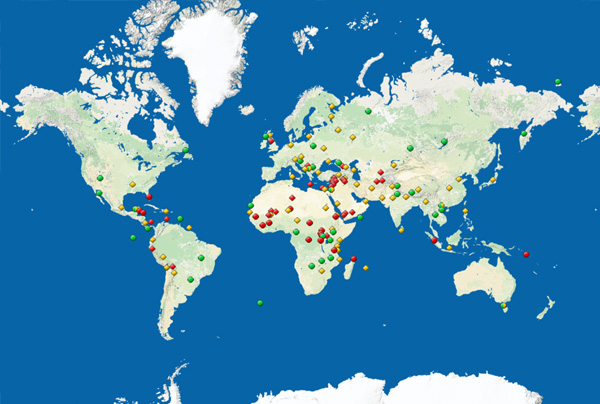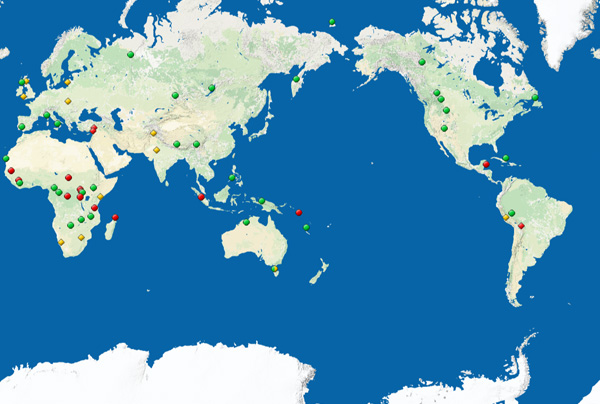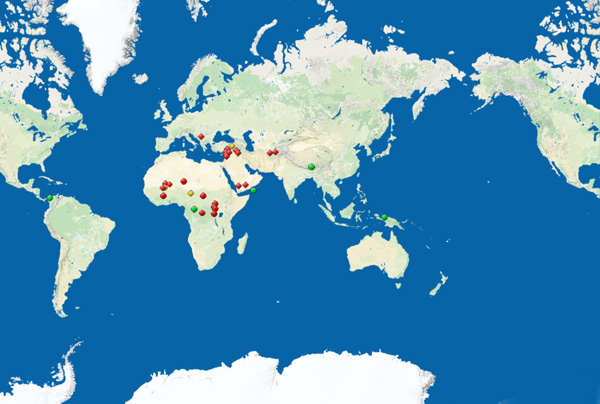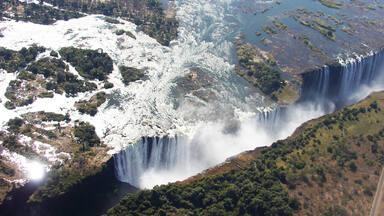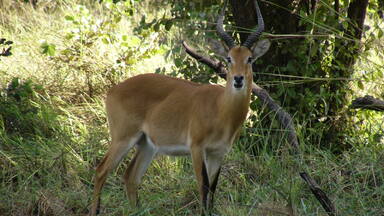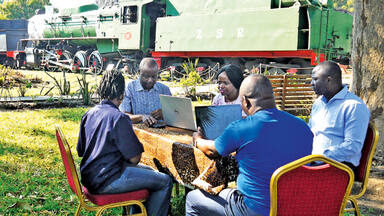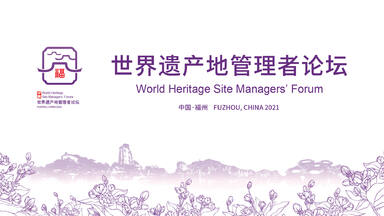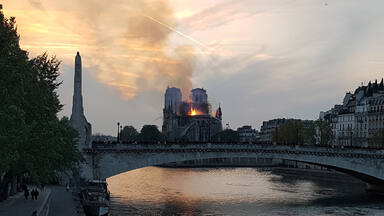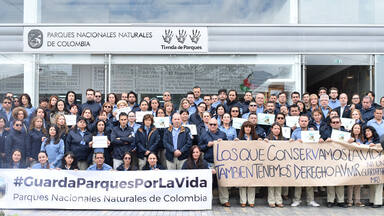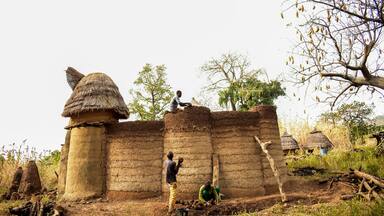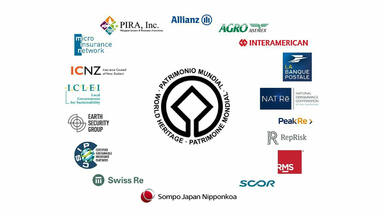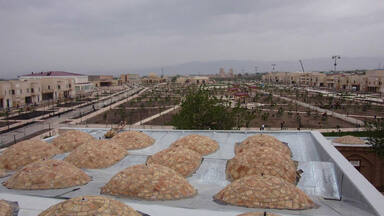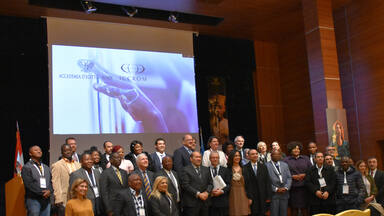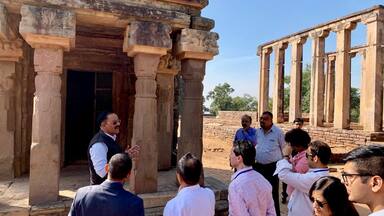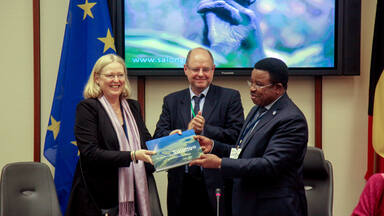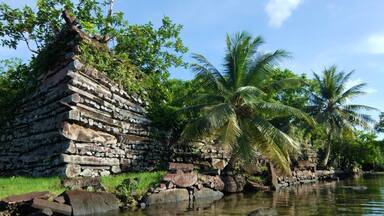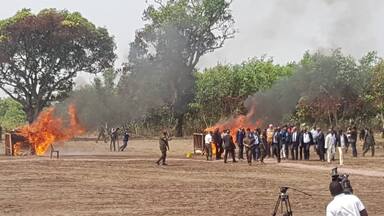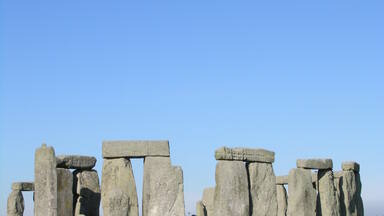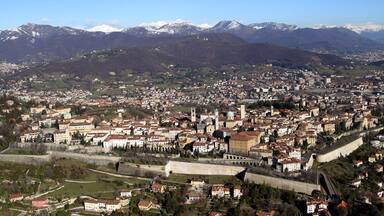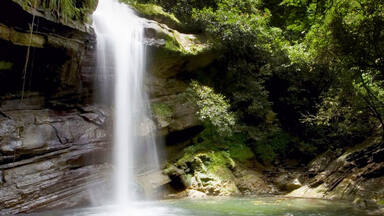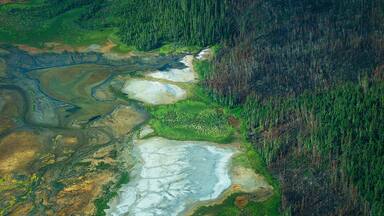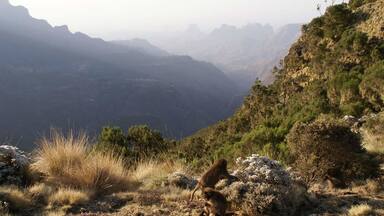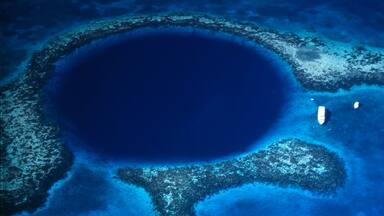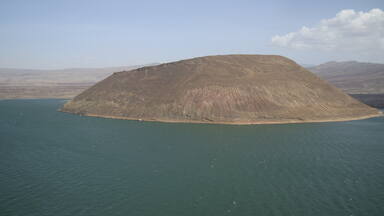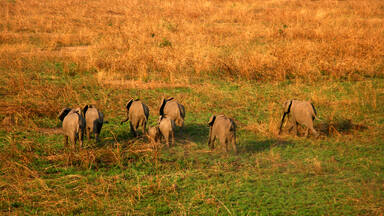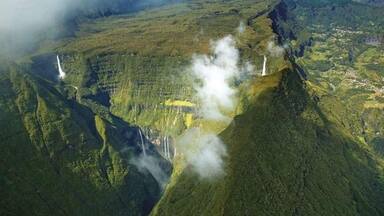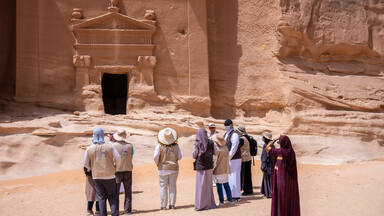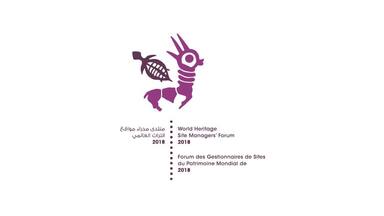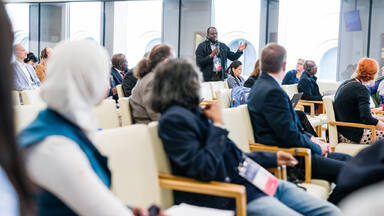The Information System offers you a trove of reliable data on the state of conservation of World Heritage properties since 1979 and the threats they have faced in the past, or are currently facing. Through this tool, you can get access to thousands of reports and decisions adopted by the World Heritage Committee, as part of one of the most comprehensive monitoring systems of any international convention.
Search and Filter
Statistics
Get a statistical insight of the conservation of World Heritage since 1979
Number of properties examined each year
Distribution of the properties examined since 1979, per region
Distribution of the properties examined since 1979, per category of heritage
Numbers
Statistical analysis
1979-2013
Analysis of the factors having
a negative impact on World Heritage properties
States Parties and Regions
Search by Region
Africa Arab States Asia and the Pacific Europe and North America Latin America and the CaribbeanSearch by State Party
Afghanistan Albania Algeria Andorra Angola Antigua and Barbuda Argentina Armenia Australia Austria Azerbaijan Bahamas Bahrain Bangladesh Barbados Belarus Belgium Belize Benin Bhutan Bolivia (Plurinational State of) Bosnia and Herzegovina Botswana Brazil Brunei Darussalam Bulgaria Burkina Faso Burundi Cabo Verde Cambodia Cameroon Canada Central African Republic Chad Chile China Colombia Comoros Congo Cook Islands Costa Rica Côte d'Ivoire Croatia Cuba Cyprus Czechia Democratic People's Republic of Korea Democratic Republic of the Congo Denmark Djibouti Dominica Dominican Republic Ecuador Egypt El Salvador Equatorial Guinea Eritrea Estonia Eswatini Ethiopia Fiji Finland France Gabon Gambia Georgia Germany Ghana Greece Grenada Guatemala Guinea Guinea-Bissau Guyana Haiti Holy See Honduras Hungary Iceland India Indonesia Iran (Islamic Republic of) Iraq Ireland Israel Italy Jamaica Japan Jordan Kazakhstan Kenya Kiribati Kuwait Kyrgyzstan Lao People's Democratic Republic Latvia Lebanon Lesotho Liberia Libya Lithuania Luxembourg Madagascar Malawi Malaysia Maldives Mali Malta Marshall Islands Mauritania Mauritius Mexico Micronesia (Federated States of) Monaco Mongolia Montenegro Morocco Mozambique Myanmar Namibia Nauru Nepal Netherlands (Kingdom of the) New Zealand Nicaragua Niger Nigeria Niue North Macedonia Norway Oman Pakistan Palau Panama Papua New Guinea Paraguay Peru Philippines Poland Portugal Qatar Republic of Korea Republic of Moldova Romania Russian Federation Rwanda Saint Kitts and Nevis Saint Lucia Saint Vincent and the Grenadines Samoa San Marino Sao Tome and Principe Saudi Arabia Senegal Serbia Seychelles Sierra Leone Singapore Slovakia Slovenia Solomon Islands Somalia South Africa South Sudan Spain Sri Lanka State of Palestine Sudan Suriname Sweden Switzerland Syrian Arab Republic Tajikistan Thailand Timor-Leste Togo Tonga Trinidad and Tobago Tunisia Türkiye Turkmenistan Tuvalu Uganda Ukraine United Arab Emirates United Kingdom of Great Britain and Northern Ireland United Republic of Tanzania United States of America Uruguay Uzbekistan Vanuatu Venezuela (Bolivarian Republic of) Viet Nam Yemen Zambia ZimbabweMaps
Get geographical visualization of the conservation of World Heritage since 1979
Reactive Monitoring process
What is Reactive Monitoring?
It is the reporting by the World Heritage Centre and the Advisory Bodies to the World Heritage Committee on the state of conservation of specific World Heritage properties that are under threat.
Which properties are reported upon?
The properties to be reported upon are selected, among all those inscribed on the World Heritage List, according to the following considerations...
How are the state of conservation reports elaborated?
The World Heritage Centre and the Advisory Bodies review all information available on the state of conservation of the properties foreseen for examination by the World Heritage Committee at its next session...
What are the decisions of the World Heritage Committee?
Subsequently to the examination of the SOC report during its ordinary session, the World Heritage Committee adopts a decision, which may take one or more of the following steps...
Why were some properties examined by the Bureau of the World Heritage Committee?
Since the early years of the World Heritage Convention (1979) until 2002, the Bureau had a substantial role in the coordination of the work of the Committee to the extent of examining all the reports on the state of conservation...
Don’t confuse Reactive Monitoring with the Periodic Reporting exercise
World Heritage properties are also reported on through the Periodic reporting exercise. Indeed...
Threats
The standard list of threats/factors affecting the Outstanding Universal Value of World Heritage properties consists of a series of 14 primary factors, encompassing each a number of secondary factors.
Useful tools and Guidance
Guidance and Advice notes
Resource Manuals
World Heritage Paper Series
Some useful Recommendations / Policies /
Strategies and Statements
- Recommendation concerning the Protection, at National Level, of the Cultural and Natural Heritage (1972)
- Policy Document for the Integration of a Sustainable Development Perspective into the Processes of the World Heritage Convention (2015)
- Policy Document on Impacts of Climate Change and World Heritage (2007)
- Strategy for Reducing Risks from Disasters at World Heritage properties (2007)
- Recommendation on the Historic Urban Landscape, including a glossary of definitions (2011)
- International Council on Mining and Metals (ICMM) - Mining and protected areas; Position statement (2003)
Reporting formats
Format for the submission of State of conservation reports
by the States Parties
Other useful online tools
Partners
Advisory Bodies to the World Heritage Committee
- ICCROM (International Centre for the Study of the Preservation and Restoration of Cultural Property)
- ICOMOS (International Council on Monuments and Sites)
- IUCN (International Union for Conservation of Nature)
Other UNESCO Conventions and Programmes
- Convention for the Protection of Cultural Property in the Event of Armed Conflict (1954) and its Second Protocol (1999)
- Convention on the Means of Prohibiting and Preventing the Illicit Import, Export and Transfer of Ownership of Cultural Property (1970)
- Intergovernmental Committee for Promoting the Return of Cultural Property to its Countries of Origin or its Restitution in case of Illicit Appropriation (1978)
- Convention on the Protection of the Underwater Cultural Heritage (2001)
- Convention for the Safeguarding of Intangible Cultural Heritage (2003)
- UNESCO Global Geoparks
- Man and the Biosphere Programme (MAB)
Other conventions and agreements
- Convention on Biological Diversity (CBD)
- Convention on International Trade in Endangered Species of Wild Fauna and Flora (CITES)
- Convention on the Conservation of Migratory Species of Wild Animals (CMS)
- International Treaty on Plant Genetic Resources for Food and Agriculture
- International Plant Protection Convention (IPPC)
- Ramsar (Convention on Wetlands)
- International Whaling Commission (IWC)
- Agreement on the Conservation of African-Eurasian Migratory Waterbirds (AEWA)
- United Nations Convention to Combat Desertification (UNCCD)
- United Nations Framework Convention on Climate Change (UNFCCC)
- International Council on Mining & Metals (ICMM) - Mining and Protected Areas
Decisions (32)
The World Heritage Committee,
Climate Action for World Heritage
- Having examined Document WHC/23/45.COM/7,
- Recalling Decisions 40 COM 7 and 44 COM 7C adopted at its 40th session (Istanbul/UNESCO, 2016) and at its extended 44th session (Fuzhou/online, 2021),
- Notes that the Panel of experts in relation to Decision 44 COM 7C concerning climate change and World Heritage met by end of March 2022 and made recommendations on the amendments proposed by the Members of the World Heritage Committee and provided a report to the Open-ended Working Group of States Parties to the World Heritage Convention on Climate Change;
- Also notes that the Open-ended Working Group of States Parties to the World Heritage Convention on Climate Change has met seven times to discuss the proposed amendments and the recommendations of the Panel of experts;
- Recognizes Climate Action for World Heritage as an important thematic area of work, thanks the Governments of Australia, Azerbaijan and the Netherlands for their generous financial support and invites States Parties to contribute towards this thematic area to enable the Secretariat to support activities related to the development of the updated Policy Document on Climate Action for World Heritage and its dissemination;
- Recalls again Decision 41 COM 7 in which the Committee ‘reiterate[d] the importance of States Parties undertaking the most ambitious implementation of the Paris Agreement adopted under the United Nations Framework Convention on Climate Change (UNFCCC) by “holding the increase in the global average temperature to well below 2°C above pre-industrial levels and by pursuing efforts to limit the global average temperature increase to 1.5°C above pre-industrial levels, recognizing that this would significantly reduce the risks and impacts of climate change” ’, again strongly urges all States Parties to undertake actions to address Climate Change under the Paris Agreement consistent with their common but differentiated responsibilities and respective capabilities, in the light of different national circumstances, that are fully consistent with their obligations within the World Heritage Convention to protect the Outstanding Universal Value of all World Heritage properties;
Improving the perception of the List of World Heritage in Danger
- Recalling Decision 40 COM 7 adopted at its 40th session (Istanbul/UNESCO, 2016),
- Reaffirming the need to promote a better understanding of the implications and benefits of properties being inscribed on the List of World Heritage in Danger,
- Takes note with appreciation of the thorough study on the perceptions of the List of World Heritage in Danger, together with its recommendations that could form the basis of a communication strategy and thanks the State Party of Norway for its financial support;
- Expresses its gratitude to all the stakeholders of the 1972 World Heritage Convention who have actively contributed to this study;
- Takes note with satisfaction of the recommendations formulated in the study on possible approaches to reverse negative perceptions and to raise the profile of the List of World Heritage in Danger as a positive tool, enhancing understanding and highlighting its importance for the protection of the Outstanding Universal Value of World Heritage properties and requests all stakeholders of the Convention to take them on-board and implement them at their level as soon as possible;
Enhancing dialogue among States Parties, Advisory Bodies and the World Heritage Centre - Recommends that the World Heritage Centre and the Advisory Bodies ensure the following steps regarding the monitoring of state of conservation of the inscribed properties:
- Whenever an expert mission takes place within the framework of the reactive monitoring process, the draft mission report will be shared, prior to its publication, with the concerned State Party to allow them to review the report and to propose corrections on any factual inaccuracies and comment on other critical issues and/or misunderstandings, and consultations will be held, if necessary, between the concerned State Party and relevant Advisory Body/ies;
- Whenever an expert mission takes place within the framework of the reactive monitoring process and the inscription of the concerned property on the List of World Heritage in Danger is recommended in the mission report, consultations will be held between the concerned State Party and relevant Advisory Body/ies, and the State Party’s view will be referred to in the mission report or in its annex in the event that the views of both parties do not converge in the consultations;
- Whenever the inscription of the property on the List of World Heritage in Danger is proposed in a working document on state of conservation produced by the World Heritage Centre and the Advisory Bodies to be examined by the Committee, consultations will be held, within the available deadlines, prior to the distribution of the document, between the concerned State Party, relevant Advisory Body/ies and the World Heritage Centre, and the State Party’s view will be referred to in the working document such as in its annex in the event that the views of the concerned parties do not converge;
- Recommends that States Parties enhance dialogue among themselves regarding properties that are or may be proposed for inscription on the List of World Heritage in Danger, in particular cases in which causes of the danger are transboundary;
- Recommends that the World Heritage Centre and the Advisory Bodies continue to work on knowledge sharing of best practice cases in which the property was removed from the List of World Heritage in Danger, and also encourage them to enhance providing capacity building for the States Parties who have properties on the List of World Heritage in Danger;
- Recommends that the budget of the World Heritage Centre and Advisory Bodies be adjusted in proportion with the additional workload generated by the additional dialogue and consultations as well as for capacity building for States Parties with properties on the List of World Heritage in Danger.
The World Heritage Committee,
- Having examined Document WHC/23/45.COM/7,
- Recalling Decisions 40 COM 7, 41 COM 7, 42 COM 7, 43 COM 7.2, and 44 COM 7.2 adopted at its 40th (Istanbul/UNESCO, 2016), 41st (Krakow, 2017), 42nd (Manama, 2018), 43rd (Baku, 2019) and extended 44th (Fuzhou/online, 2021) sessions respectively,
- Also recalling that all proposed major interventions in and around World Heritage properties should be subject to rigorous impact assessments, as outlined in Paragraph 118bis of the Operational Guidelines, in line with the Guidance and Toolkit for Impact Assessments in a World Heritage Context, and that both the proposals and the impact assessment-related documentation be submitted, in accordance with Paragraph 172 of the Operational Guidelines, to the World Heritage Centre for review by the Advisory Bodies, before any intervention for new construction, demolition, modification, recovery or reconstruction commences or decisions made that cannot be reversed;
Emergency situations resulting from conflicts
- Expresses utmost concern that conflicts (including armed conflict and civil unrest) continue to represent a major threat to World Heritage properties and remain one of the major reasons for the inscription of properties on the List of World Heritage in Danger;
- Regrets the loss of human life and the degradation of humanitarian conditions resulting from the prevailing conflict situations in several countries, including threats to the personnel and local communities, as well as the continuing threats facing cultural and natural heritage in regions of armed conflict where there are significant concerns regarding security in and around World Heritage properties;
- Welcomes protection and conservation efforts being undertaken by the concerned States Parties at World Heritage properties and that the States Parties are progressively proceeding with the development of corrective measures and the definition of the Desired state of conservation for the removal of the properties from the List of World Heritage in Danger (DSOCR) for some cultural properties following due process;
- Urges again all parties associated with conflicts to ensure the protection of cultural and natural heritage, including to avoid their use for military purposes and also urges States Parties to fulfil their obligations under international law, including the 1954 Convention and its two Protocols, by taking all possible measures to protect such heritage, including of World Heritage properties and sites included in Tentative Lists;
- Reiterates its utmost concern about the continuing threats of wildlife poaching and illegal trafficking of wildlife and timber products linked to impacts of armed conflict and organized crime, which is eroding the biodiversity and Outstanding Universal Value of World Heritage properties around the world, and further urges States Parties to take the necessary measures to curb this problem, including through the implementation of the Convention on International Trade in Endangered Species of Wild Fauna and Flora (CITES);
- Also reiterates its utmost concern at the increase in illicit trafficking of cultural objects, resulting from armed conflicts, and appeals to all States Parties to cooperate in the fight against these threats, and for cultural heritage protection in general, including through the ratification of the 1970 Convention and the 1954 Convention and its two Protocols, as well as the implementation of United Nations Security Council Resolutions 2199 (2015), 2253 (2015) and 2347 (2017), and the implementation of the UNESCO Recommendations on Museums and Collections (2015);
- Welcomes the World Heritage Centre and the Advisory Bodies’ continued actions in responding to emergencies and conflicts threatening cultural and natural heritage, including the Outstanding Universal Value, including through the Revive the Spirit of Mosul and the Li Beirut initiatives, the Heritage Emergency Fund (HEF) and the Rapid Response Facility (RRF) and also UNESCO actions in Ukraine and emergency programmes in Sudan, Syria, Yemen, Iraq, Libya, Democratic Republic of the Congo, Benin, Burkina Faso, Niger, Mali, Central African Republic, Palestine, and other countries;
- Reiterates its call upon the international community to further support the safeguarding of the cultural and natural heritage of countries affected by conflict, through earmarked funds or through contributions to the UNESCO World Heritage Fund, HEF and RRF;
Recovery and Reconstruction
- Recalls that reconstruction is justifiable only in exceptional circumstances, and should be based on thorough documentation, guided by conservation plans and policies that support the Outstanding Universal Value (OUV), and as outlined in Paragraph 86 of the Operational Guidelines;
- Takes note of the various programmes initiated and implemented by the World Heritage Centre and the Advisory Bodies and other international partners to respond to the destruction of heritage through documentation, emergency response, recovery and reconstruction;
- Welcomes the continued efforts by States Parties in responding to post-conflict and post-disaster recovery and reconstruction, including the various reconstruction projects nearing completion, as well as their positive social and community interlinkages and thanks France, Germany, Japan, Norway, the Republic of Korea, Spain, the Sultanate of Oman, the United Arab Emirates, the European Union, the International Alliance for the Protection of Heritage in Conflict Areas (ALIPH), the Heritage Emergency Fund and the Arab Regional Centre for World Heritage (ARC-WH) for their generous support, including for the reconstruction of the House of Wonder, an emblematic building in East Africa, in the Stone Town of Zanzibar, United Republic of Tanzania;
- Encourages all State Parties to prepare comprehensive risk preparedness strategies and emergency response plans for World Heritage properties that are exposed to risk from natural disasters;
- Requests States Parties to ensure the integrity of the OUV of World Heritage properties and that all recovery and reconstruction projects be guided by thorough and comprehensive recovery proposals, including plans and drawings, integrated and aligned with the needs of local communities and subject to rigorous impact assessments as noted in Paragraph 3 above;
Kunming-Montreal Global Biodiversity Framework
- Welcomes the adoption of the Kunming-Montreal Global Biodiversity Framework (GBF) during the fifteenth meeting of the Conference of the Parties (COP-15) to the Convention on Biological Diversity (CBD) in December 2022 to set the global pathway to halt and reverse biodiversity loss by 2030, in line with the 2030 Agenda for Sustainable Development;
- Requests the States Parties to fully harness the World Heritage Convention in supporting the goals and targets of the GBF, including through effective collaboration among convention focal points, and by integrating World Heritage-related objectives within their National Biodiversity Strategies and Action Plans (NBSAPs);
- Also requests the World Heritage Centre, in collaboration with the Advisory Bodies, to identify and develop coordinated actions on World Heritage and the GBF, including specific guidance on how the World Heritage Convention might contribute to the aims of the Joint Programme of Work on the Links between Biological and Cultural Diversity, subject to the availability of resources, and to integrate reporting on progress regarding contributions of World Heritage to the GBF under the Committee’s item on Sustainable Development and invites States Parties to contribute financially for this purpose;
Urban pressure
- Notes that pressures on historic urban areas arising from inappropriate urban development interventions and inadequate development controls, rapid and inadequately planned development, including large development projects, additions that are incompatible in their volume, tourism and transportation infrastructure, as well as the accumulated impact of incremental changes, have continued within numerous World Heritage properties and in their buffer zones and settings, and considers that these present significant potential and ascertained major threats to the Outstanding Universal Value of properties, including their integrity and authenticity, and increase their vulnerability to disasters, such as those resulting from climate change;
- Also noting that the findings of the UNESCO Third Member State Consultation on the Implementation of the 2011 Recommendation on the Historic Urban Landscape (2011 Recommendation) request States Parties to implement the 2011 Recommendation in urban World Heritage properties and, with technical assistance from the World Heritage Centre and the Advisory Bodies, to integrate it as a tool in the monitoring processes of the state of conservation, and the preparation and updating of management plans concerning nomination process for World Heritage properties in cities and settlements including with the support of the World Heritage Urban Heritage Atlas tool;
- Recalls the essential contribution of local communities, and the importance of their participation in decision-making processes, as well as the need to support sustainable, compatible, and inclusive livelihoods for local communities and further requests States Parties to embed stakeholder engagement in management systems and processes, in line with Paragraph 12 of the Operational Guidelines, with the 2011 Recommendation and the Policy on the Integration of a Sustainable Development Perspective into the Processes of the World Heritage Convention (2015);
- Invites all States Parties to establish governance mechanisms for urban heritage that support coordination and coherence across different sectors such as infrastructure, tourism, transport, and urban development to integrate heritage management into the plans and processes of the settlement and the region;
- Stresses the importance of carrying out impact assessments to evaluate and thereby avoid or manage potential threats to the OUV of properties, including their authenticity and integrity, arising from new urban development projects in line with paragraph 3 above;
- Also emphasizes the need to enhance resilience of World Heritage properties in urban areas vulnerable to climate change-related impacts, in line with the 2011 Recommendation and the outcomes of the activities of the UNESCO World Heritage Cities Programme;
Infrastructure development - Notes with concern the growing pressure of infrastructure development, such as extractive mining activities, dams, hydropower, transportation infrastructure, and the expansion of tourism infrastructure, on the Outstanding Universal Value of World Heritage properties;
- Welcomes the commitment announced by the International Hydropower Association (IHA) that no new hydropower projects should be developed in World Heritage properties, and a duty of care pledge to implement high standards of performance and transparency for any hydropower projects outside of but affecting protected areas such as World Heritage properties;
- Strongly urges all States Parties, development proponents and financiers to incorporate the Guidance and Toolkit for Impact Assessments in a World Heritage Context into planning and decision-making processes to contribute to safeguarding the OUV of World Heritage properties, in line with Paragraph 3 above;
- Requests all States Parties to:
- Inform the World Heritage Centre of any planned developments located within a World Heritage property, its buffer zone or in its wider setting that may impact on its OUV, prior to making any decision that would be difficult to reverse, in conformity with Paragraph 172 of the Operational Guidelines,
- Ensure that the potential impacts of developments on the OUV are appropriately assessed, in line with Paragraph 3 above,
- Ensure that no proposed developments proceed that would negatively impact on the OUV,
- Ensure that no deliberate measures are taken, which might damage directly or indirectly the inscribed properties situated on the territory of other States Parties to the Convention, in conformity with Article 6 of the World Heritage Convention;
Corporate Sector and the World Heritage ‘no-go’ commitment -
Welcomes the launch of the UNESCO Guidance for the World Heritage ‘No-Go’ Commitment: Global standards for corporate sustainability as a means to assist the corporate sector to develop or update their policies and strategies to safeguard World Heritage, and thanks the Government of Flanders (Belgium) for its financial support;
-
Requests the World Heritage Centre, in collaboration with the Advisory Bodies, to continue its collaboration with the corporate sector in view of supporting the adoption and implementation of World Heritage safeguard policies, and invites companies and relevant organisations to develop and update their corporate sustainability policies in line with the UNESCO guidance, and lodge them with UNESCO;
Rights-based Issues
- Recalling Article 5 of the Convention that each State Party shall adopt for each country a general policy, which aims to give the cultural and natural heritage a function in the life of the community, and the integration of the protection of that heritage into comprehensive planning programmes are means of ensuring effective protection, conservation and presentation of cultural and natural heritage,
- Also recalling the Universal Declaration of Human Rights, the International Covenant on Economic, Social and Cultural Rights, the International Covenant on Civil and Political Rights, and the United Nations Declaration on the Rights of Indigenous Peoples,
- Further recalling the various provisions of the Operational Guidelines that encourage States Parties to adopt a human rights-based approach to the nomination and subsequent effective management of inscribed World Heritage properties,
- Bearing in mind that specific and significant spiritual meanings are mentioned to justify the Outstanding Universal Value of a large number of the World Heritage properties to be found in most countries around the world, also recalling a number of research studies and analyses of religious heritage and sacred sites carried out by the Advisory Bodies,
- Underlining that living religious and sacred sites require specific approach and policies for protection and management that take into account their distinct spiritual nature, crucial to their Outstanding Universal Value, as a key factor in their conservation and that such policies cannot be sustainable without in-depth consultation with the appropriate stakeholders;
- Calls upon all States Parties to ensure that human rights, including cultural rights, are protected as an integral part of the management of World Heritage properties by establishing equitable and participatory governance arrangements;
- Strongly condemns all forms of human rights violations and abuses towards indigenous peoples and local communities (IPLCs), including any forced eviction;
- Notes with utmost concern the reported cases of alleged human rights abuses towards IPLCs in and around World Heritage properties and therefore, strongly urges the States Parties concerned to urgently investigate the allegations and take appropriate actions to address their findings, following an equitably governed consultative process with the participation and decision making of all rightsholders and stakeholders;
- Reminds States Parties of their obligations to ensure that the management of World Heritage properties follows a rights-based approach that includes full involvement of all rightsholders and stakeholders, in particular IPLCs, in line with the 2015 Policy on World Heritage and Sustainable Development, the UNESCO Policy on Engaging with Indigenous Peoples and the 2030 Agenda for Sustainable Development and international human rights standards;
- Requests the Secretariat, with the Advisory Bodies, to enhance activities in the framework of the Initiative on Heritage of Religious Interest and to resume elaboration of the thematic paper proposing to the States Parties general guidance regarding the management of their cultural and natural heritage of religious interest, and in compliance with the national specificities, and invites the States Parties to provide voluntary contributions to this end;
Earth observation and spatial data for World Heritage conservation
- Welcomes the development of the World Heritage Online Mapping Platform to provide a comprehensive, complete, accurate and geo-referenced dataset for the World Heritage properties that, in the pilot phase of the project, are in the Europe and North America region, and thanks the Government of Flanders (Belgium) for the support provided to the pilot phase of the project;
- Also welcomes the Urban Heritage Atlas platform and tool for geo-referenced cultural mapping of the attributes of urban heritage and invites States Parties to use the tool for better managing their World Heritage properties and takes note with satisfaction of the continued activities of the Urban Heritage Climate Observatory applying earth observation tools for World Heritage cities;
- Invites States Parties to contribute to the above-mentioned platforms and tools with already available GIS data, complementary narrative and visual analysis, expertise, networks, and financial resources;
- Reiterates its request to States Parties, the World Heritage Centre and the Advisory Bodies, to strengthen collaborative partnerships with UNESCO Category 2 Centres and other relevant institutions with a view to furthering the necessary institutional and individual capacity needed to make full use of spatial data, Earth observation satellite technologies and analysis tools for the monitoring of the state of conservation of World Heritage properties.
The World Heritage Committee,
1. Having examined Documents WHC-05/29.COM/7A and WHC-05/29.COM/7B.Rev,2. Wishing to motivate and assist State Parties to get properties removed from the List of World Heritage in Danger,
3. Encouraging greater international cooperation among States Parties in order to reduce the number of properties on the List of World Heritage in Danger,
4. Wishing to improve the consistency and effectiveness of state of conservation reports both with respect to properties on the World Heritage List and the List of World Heritage in Danger,
5. Reiterates that reports of missions to review the state of conservation of properties on the World Heritage List, in conformity with paragraph 173 of the Operational Guidelines, must include:
a) an indication of threats or significant improvement in the conservation of the property since the last report to the World Heritage Committee;
b) any follow-up to previous decisions of the World Heritage Committee to the state of conservation of the property; and
c) information on any threat or damage to or loss of outstanding universal value, integrity and/or authenticity for which the property was inscribed on the World Heritage List;
6. Emphasizes that whenever further action is needed, clear benchmarks are set indicating the corrective measures to be taken in order to achieve significant improvement of the conservation as well as a timeframe within which the benchmarks will have to be met;
7. Requests the full cooperation of States Parties, Advisory Bodies and the World Heritage Centre in the state of conservation reporting process;
8. Further requests that in addition to information about the amounts and purposes of international assistance of the World Heritage Fund received by a property, a state of conservation report should also indicate the amount of extra budgetary funds received or needed;
9. Decides to discuss further at its 30th session (Vilnius, 2006) the possibility of deferring the decision to inscribe new properties on the World Heritage List of a State Party that does not submit full reports requested by the Committee for two consecutive ordinary sessions of the Committee;
10. Decides, with respect to properties on the List of World Heritage in Danger, in accordance with Section IV.B of the Operational Guidelines:
a) to clearly identify the threats and dangers for which a property is to be inscribed on the List of World Heritage in Danger and how serious they are,
b) to set at the time of inscription on the List of World Heritage in Danger clear benchmarks indicating the corrective action to be taken to address the ascertained and potential dangers;
c) to set a timeframe within which the benchmarks will have to be met in order for a property to be removed from the List of World Heritage in Danger;
d) to request the World Heritage Centre and the Advisory Bodies for properties already on the List of World Heritage in Danger, for which at the time of inscription no benchmarks were set, to include in future reports regarding those sites benchmarks indicating the corrective action to be taken to address ascertained and potential dangers as well as a timeframe;
e) to request the Advisory Bodies to evaluate upon request of the State Party or of the Committee the impact of the ascertained and potential dangers on the outstanding universal value of World Heritage properties as set out in the Statement of outstanding universal value, referred to in paragraph 155 of the Operational Guidelines; and
f) to request States Parties to submit an annual report on the progress towards meeting the benchmarks within the timeframe set with respect to their properties on the List of World Heritage in Danger;
11. Also decides with respect to properties on the World Heritage List to explicitly discuss all state of conservation reports indicating non-compliance with Committee decisions, non-appliance of corrective measures or otherwise a lack of cooperation on the part of a State Party, as well as reports indicating difficulties encountered by a State Party in its efforts to conserve its sites (List A).
Read more about the decisionThe World Heritage Committee,
1. Requests the Secretariat in consultation with the Advisory Bodies, to ensure that all properties included in the future state of conservation documents, are treated in compliance with the procedures set out in the Operational Guidelines for the implementation of World Heritage Convention for reactive monitoring (paragraph 68, July 2002);
2. Requests that reports of missions to review the state of conservation of World Heritage properties include, as appropriate:
(a) an indication of threats or significant improvement in the conservation of the property since the last report to the World Heritage Committee,
(b) any follow-up to previous decisions of the World Heritage Committee on the state of conservation of the property,
(c) information on any threat or damage to or loss of outstanding universal value, integrity and/or authenticity for which the property was inscribed on the World Heritage List;
3. Further requests that the reports are categorized as follows:
(a) reports with recommended decisions which, in the judgment of the World Heritage Centre in consultation with the Advisory Bodies, require discussion by the World Heritage Committee,
(b) reports which, in the judgment of the World Heritage Centre in consultation with the Advisory Bodies, can be noted without discussion,
Reports in category (b) will not be discussed unless a request is made to the Chairperson of the World Heritage Committee in advance of the discussion of this agenda item;
4. Invites the World Heritage Centre to present all information on the state of conservation of properties inscribed on the World Heritage List in the following manner:
(a) the report on each property should start on a new page,
(b) the identification number of the property allocated at the time of its nomination should be used in the document,
(c) an index of all properties should also be included,
(d) the decisions should have a standard layout, draft recommendation, and should be concise and operational;
5. Reaffirms that the deadline to receive reports by the World Heritage Centre from States Parties is 1 February of each year.
Read more about the decisionThe World Heritage Committee,
1. Noting with concern, during the examination of the state of conservation of the properties inscribed on the World Heritage List, the multiplication of inappropriate pastiche buildings which falsify history,
2. Invites, in consequence, the States Parties to encourage a contemporary architecture of quality, respectful of the past, which integrates harmoniously with its environment.
Read more about the decisionThe World Heritage Committee,
- Having examined Document WHC/23/45.COM/7,
- Recalling Decisions 40 COM 7, 41 COM 7, 42 COM 7, 43 COM 7.2, and 44 COM 7.2 adopted at its 40th (Istanbul/UNESCO, 2016), 41st (Krakow, 2017), 42nd (Manama, 2018), 43rd (Baku, 2019) and extended 44th (Fuzhou/online, 2021) sessions respectively,
- Also recalling that all proposed major interventions in and around World Heritage properties should be subject to rigorous impact assessments, as outlined in Paragraph 118bis of the Operational Guidelines, in line with the Guidance and Toolkit for Impact Assessments in a World Heritage Context, and that both the proposals and the impact assessment-related documentation be submitted, in accordance with Paragraph 172 of the Operational Guidelines, to the World Heritage Centre for review by the Advisory Bodies, before any intervention for new construction, demolition, modification, recovery or reconstruction commences or decisions made that cannot be reversed;
Emergency situations resulting from conflicts
- Expresses utmost concern that conflicts (including armed conflict and civil unrest) continue to represent a major threat to World Heritage properties and remain one of the major reasons for the inscription of properties on the List of World Heritage in Danger;
- Regrets the loss of human life and the degradation of humanitarian conditions resulting from the prevailing conflict situations in several countries, including threats to the personnel and local communities, as well as the continuing threats facing cultural and natural heritage in regions of armed conflict where there are significant concerns regarding security in and around World Heritage properties;
- Welcomes protection and conservation efforts being undertaken by the concerned States Parties at World Heritage properties and that the States Parties are progressively proceeding with the development of corrective measures and the definition of the Desired state of conservation for the removal of the properties from the List of World Heritage in Danger (DSOCR) for some cultural properties following due process;
- Urges again all parties associated with conflicts to ensure the protection of cultural and natural heritage, including to avoid their use for military purposes and also urges States Parties to fulfil their obligations under international law, including the 1954 Convention and its two Protocols, by taking all possible measures to protect such heritage, including of World Heritage properties and sites included in Tentative Lists;
- Reiterates its utmost concern about the continuing threats of wildlife poaching and illegal trafficking of wildlife and timber products linked to impacts of armed conflict and organized crime, which is eroding the biodiversity and Outstanding Universal Value of World Heritage properties around the world, and further urges States Parties to take the necessary measures to curb this problem, including through the implementation of the Convention on International Trade in Endangered Species of Wild Fauna and Flora (CITES);
- Also reiterates its utmost concern at the increase in illicit trafficking of cultural objects, resulting from armed conflicts, and appeals to all States Parties to cooperate in the fight against these threats, and for cultural heritage protection in general, including through the ratification of the 1970 Convention and the 1954 Convention and its two Protocols, as well as the implementation of United Nations Security Council Resolutions 2199 (2015), 2253 (2015) and 2347 (2017), and the implementation of the UNESCO Recommendations on Museums and Collections (2015);
- Welcomes the World Heritage Centre and the Advisory Bodies’ continued actions in responding to emergencies and conflicts threatening cultural and natural heritage, including the Outstanding Universal Value, including through the Revive the Spirit of Mosul and the Li Beirut initiatives, the Heritage Emergency Fund (HEF) and the Rapid Response Facility (RRF) and also UNESCO actions in Ukraine and emergency programmes in Sudan, Syria, Yemen, Iraq, Libya, Democratic Republic of the Congo, Benin, Burkina Faso, Niger, Mali, Central African Republic, Palestine, and other countries;
- Reiterates its call upon the international community to further support the safeguarding of the cultural and natural heritage of countries affected by conflict, through earmarked funds or through contributions to the UNESCO World Heritage Fund, HEF and RRF;
Recovery and Reconstruction
- Recalls that reconstruction is justifiable only in exceptional circumstances, and should be based on thorough documentation, guided by conservation plans and policies that support the Outstanding Universal Value (OUV), and as outlined in Paragraph 86 of the Operational Guidelines;
- Takes note of the various programmes initiated and implemented by the World Heritage Centre and the Advisory Bodies and other international partners to respond to the destruction of heritage through documentation, emergency response, recovery and reconstruction;
- Welcomes the continued efforts by States Parties in responding to post-conflict and post-disaster recovery and reconstruction, including the various reconstruction projects nearing completion, as well as their positive social and community interlinkages and thanks France, Germany, Japan, Norway, the Republic of Korea, Spain, the Sultanate of Oman, the United Arab Emirates, the European Union, the International Alliance for the Protection of Heritage in Conflict Areas (ALIPH), the Heritage Emergency Fund and the Arab Regional Centre for World Heritage (ARC-WH) for their generous support, including for the reconstruction of the House of Wonder, an emblematic building in East Africa, in the Stone Town of Zanzibar, United Republic of Tanzania;
- Encourages all State Parties to prepare comprehensive risk preparedness strategies and emergency response plans for World Heritage properties that are exposed to risk from natural disasters;
- Requests States Parties to ensure the integrity of the OUV of World Heritage properties and that all recovery and reconstruction projects be guided by thorough and comprehensive recovery proposals, including plans and drawings, integrated and aligned with the needs of local communities and subject to rigorous impact assessments as noted in Paragraph 3 above;
Kunming-Montreal Global Biodiversity Framework
- Welcomes the adoption of the Kunming-Montreal Global Biodiversity Framework (GBF) during the fifteenth meeting of the Conference of the Parties (COP-15) to the Convention on Biological Diversity (CBD) in December 2022 to set the global pathway to halt and reverse biodiversity loss by 2030, in line with the 2030 Agenda for Sustainable Development;
- Requests the States Parties to fully harness the World Heritage Convention in supporting the goals and targets of the GBF, including through effective collaboration among convention focal points, and by integrating World Heritage-related objectives within their National Biodiversity Strategies and Action Plans (NBSAPs);
- Also requests the World Heritage Centre, in collaboration with the Advisory Bodies, to identify and develop coordinated actions on World Heritage and the GBF, including specific guidance on how the World Heritage Convention might contribute to the aims of the Joint Programme of Work on the Links between Biological and Cultural Diversity, subject to the availability of resources, and to integrate reporting on progress regarding contributions of World Heritage to the GBF under the Committee’s item on Sustainable Development and invites States Parties to contribute financially for this purpose;
Urban pressure
- Notes that pressures on historic urban areas arising from inappropriate urban development interventions and inadequate development controls, rapid and inadequately planned development, including large development projects, additions that are incompatible in their volume, tourism and transportation infrastructure, as well as the accumulated impact of incremental changes, have continued within numerous World Heritage properties and in their buffer zones and settings, and considers that these present significant potential and ascertained major threats to the Outstanding Universal Value of properties, including their integrity and authenticity, and increase their vulnerability to disasters, such as those resulting from climate change;
- Also noting that the findings of the UNESCO Third Member State Consultation on the Implementation of the 2011 Recommendation on the Historic Urban Landscape (2011 Recommendation) request States Parties to implement the 2011 Recommendation in urban World Heritage properties and, with technical assistance from the World Heritage Centre and the Advisory Bodies, to integrate it as a tool in the monitoring processes of the state of conservation, and the preparation and updating of management plans concerning nomination process for World Heritage properties in cities and settlements including with the support of the World Heritage Urban Heritage Atlas tool;
- Recalls the essential contribution of local communities, and the importance of their participation in decision-making processes, as well as the need to support sustainable, compatible, and inclusive livelihoods for local communities and further requests States Parties to embed stakeholder engagement in management systems and processes, in line with Paragraph 12 of the Operational Guidelines, with the 2011 Recommendation and the Policy on the Integration of a Sustainable Development Perspective into the Processes of the World Heritage Convention (2015);
- Invites all States Parties to establish governance mechanisms for urban heritage that support coordination and coherence across different sectors such as infrastructure, tourism, transport, and urban development to integrate heritage management into the plans and processes of the settlement and the region;
- Stresses the importance of carrying out impact assessments to evaluate and thereby avoid or manage potential threats to the OUV of properties, including their authenticity and integrity, arising from new urban development projects in line with paragraph 3 above;
- Also emphasizes the need to enhance resilience of World Heritage properties in urban areas vulnerable to climate change-related impacts, in line with the 2011 Recommendation and the outcomes of the activities of the UNESCO World Heritage Cities Programme;
Infrastructure development - Notes with concern the growing pressure of infrastructure development, such as extractive mining activities, dams, hydropower, transportation infrastructure, and the expansion of tourism infrastructure, on the Outstanding Universal Value of World Heritage properties;
- Welcomes the commitment announced by the International Hydropower Association (IHA) that no new hydropower projects should be developed in World Heritage properties, and a duty of care pledge to implement high standards of performance and transparency for any hydropower projects outside of but affecting protected areas such as World Heritage properties;
- Strongly urges all States Parties, development proponents and financiers to incorporate the Guidance and Toolkit for Impact Assessments in a World Heritage Context into planning and decision-making processes to contribute to safeguarding the OUV of World Heritage properties, in line with Paragraph 3 above;
- Requests all States Parties to:
- Inform the World Heritage Centre of any planned developments located within a World Heritage property, its buffer zone or in its wider setting that may impact on its OUV, prior to making any decision that would be difficult to reverse, in conformity with Paragraph 172 of the Operational Guidelines,
- Ensure that the potential impacts of developments on the OUV are appropriately assessed, in line with Paragraph 3 above,
- Ensure that no proposed developments proceed that would negatively impact on the OUV,
- Ensure that no deliberate measures are taken, which might damage directly or indirectly the inscribed properties situated on the territory of other States Parties to the Convention, in conformity with Article 6 of the World Heritage Convention;
Corporate Sector and the World Heritage ‘no-go’ commitment -
Welcomes the launch of the UNESCO Guidance for the World Heritage ‘No-Go’ Commitment: Global standards for corporate sustainability as a means to assist the corporate sector to develop or update their policies and strategies to safeguard World Heritage, and thanks the Government of Flanders (Belgium) for its financial support;
-
Requests the World Heritage Centre, in collaboration with the Advisory Bodies, to continue its collaboration with the corporate sector in view of supporting the adoption and implementation of World Heritage safeguard policies, and invites companies and relevant organisations to develop and update their corporate sustainability policies in line with the UNESCO guidance, and lodge them with UNESCO;
Rights-based Issues
- Recalling Article 5 of the Convention that each State Party shall adopt for each country a general policy, which aims to give the cultural and natural heritage a function in the life of the community, and the integration of the protection of that heritage into comprehensive planning programmes are means of ensuring effective protection, conservation and presentation of cultural and natural heritage,
- Also recalling the Universal Declaration of Human Rights, the International Covenant on Economic, Social and Cultural Rights, the International Covenant on Civil and Political Rights, and the United Nations Declaration on the Rights of Indigenous Peoples,
- Further recalling the various provisions of the Operational Guidelines that encourage States Parties to adopt a human rights-based approach to the nomination and subsequent effective management of inscribed World Heritage properties,
- Bearing in mind that specific and significant spiritual meanings are mentioned to justify the Outstanding Universal Value of a large number of the World Heritage properties to be found in most countries around the world, also recalling a number of research studies and analyses of religious heritage and sacred sites carried out by the Advisory Bodies,
- Underlining that living religious and sacred sites require specific approach and policies for protection and management that take into account their distinct spiritual nature, crucial to their Outstanding Universal Value, as a key factor in their conservation and that such policies cannot be sustainable without in-depth consultation with the appropriate stakeholders;
- Calls upon all States Parties to ensure that human rights, including cultural rights, are protected as an integral part of the management of World Heritage properties by establishing equitable and participatory governance arrangements;
- Strongly condemns all forms of human rights violations and abuses towards indigenous peoples and local communities (IPLCs), including any forced eviction;
- Notes with utmost concern the reported cases of alleged human rights abuses towards IPLCs in and around World Heritage properties and therefore, strongly urges the States Parties concerned to urgently investigate the allegations and take appropriate actions to address their findings, following an equitably governed consultative process with the participation and decision making of all rightsholders and stakeholders;
- Reminds States Parties of their obligations to ensure that the management of World Heritage properties follows a rights-based approach that includes full involvement of all rightsholders and stakeholders, in particular IPLCs, in line with the 2015 Policy on World Heritage and Sustainable Development, the UNESCO Policy on Engaging with Indigenous Peoples and the 2030 Agenda for Sustainable Development and international human rights standards;
- Requests the Secretariat, with the Advisory Bodies, to enhance activities in the framework of the Initiative on Heritage of Religious Interest and to resume elaboration of the thematic paper proposing to the States Parties general guidance regarding the management of their cultural and natural heritage of religious interest, and in compliance with the national specificities, and invites the States Parties to provide voluntary contributions to this end;
Earth observation and spatial data for World Heritage conservation
- Welcomes the development of the World Heritage Online Mapping Platform to provide a comprehensive, complete, accurate and geo-referenced dataset for the World Heritage properties that, in the pilot phase of the project, are in the Europe and North America region, and thanks the Government of Flanders (Belgium) for the support provided to the pilot phase of the project;
- Also welcomes the Urban Heritage Atlas platform and tool for geo-referenced cultural mapping of the attributes of urban heritage and invites States Parties to use the tool for better managing their World Heritage properties and takes note with satisfaction of the continued activities of the Urban Heritage Climate Observatory applying earth observation tools for World Heritage cities;
- Invites States Parties to contribute to the above-mentioned platforms and tools with already available GIS data, complementary narrative and visual analysis, expertise, networks, and financial resources;
- Reiterates its request to States Parties, the World Heritage Centre and the Advisory Bodies, to strengthen collaborative partnerships with UNESCO Category 2 Centres and other relevant institutions with a view to furthering the necessary institutional and individual capacity needed to make full use of spatial data, Earth observation satellite technologies and analysis tools for the monitoring of the state of conservation of World Heritage properties.
The World Heritage Committee,
Invites the Director-General to present a report and statistics on the state of conservation reports of properties inscribed on the World Heritage List and the List of World Heritage in Danger at its extraordinary session in March 2003.
Read more about the decision
